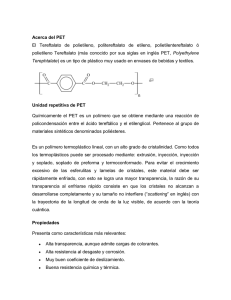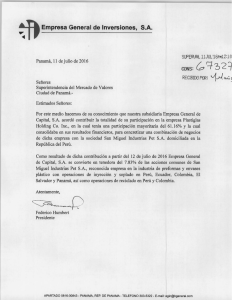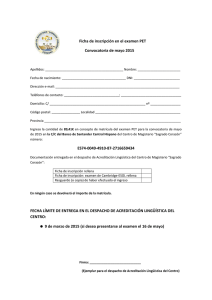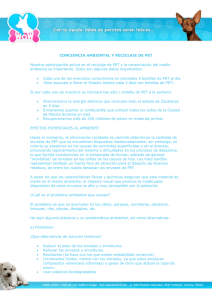Polímeros PET PET Polymers
Anuncio
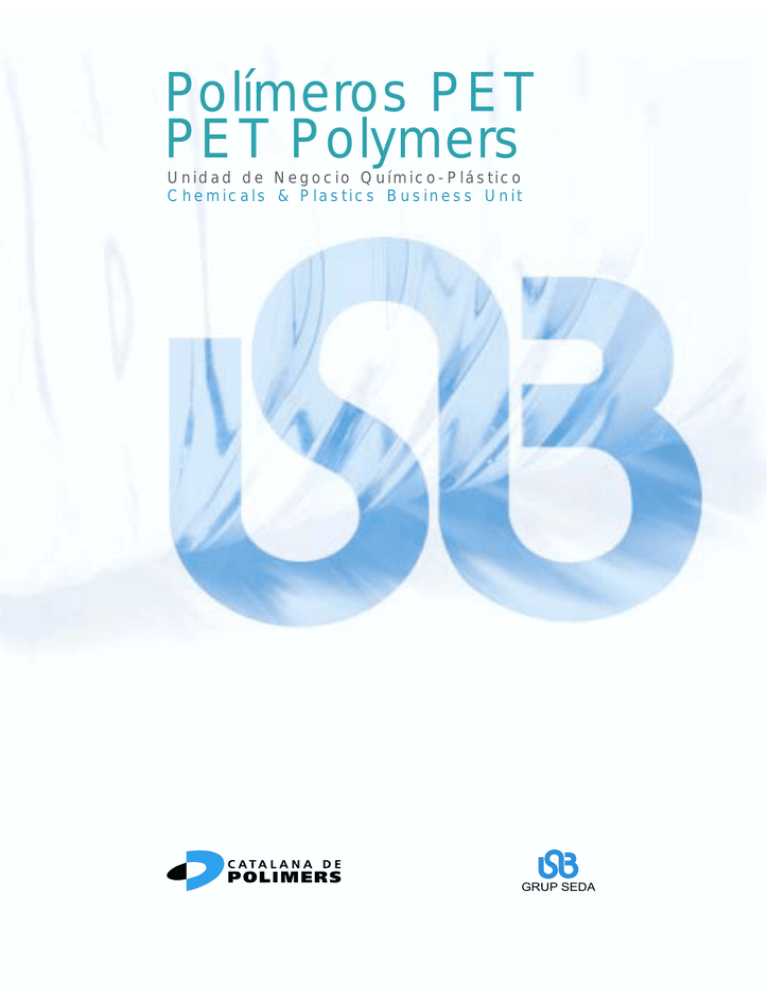
Polímeros PET PE T Polymers Unidad de Negocio Químico-Plástico Chemicals & Plastics Business Unit GRUP SEDA Polietilentereftalato El Polietilentereftalato es un Poliéster, comúnmente llamado PET, que pertenece a la familia de los termoplásticos, es decir, aquellos materiales que pueden ser moldeados cuando se calientan, pudiendo repetir este ciclo infinitas veces. Si bien en un principio se empleaba únicamente para la fabricación de fibras textiles, las propiedades mecánicas y químicas de este polímero le abrieron nuevas y prometedoras aplicaciones en el campo del envasado de alimentos y bebidas. Sus excelentes características de brillo, transparencia, elevada resistencia al impacto, baja permeabilidad a los gases y estabilidad dimensional garantizan los requisitos exigidos a los envases destinados a la conservación y transporte de productos de uso alimentario. Además, dada su composición, el PET es un material reciclable. En estos últimos años el campo de aplicación del PET se ha extendido al ámbito farmacéutico, cosmética, productos de limpieza y al sector de los laminados y films. PRESENTE EN TU VIDA Commonly known as PET, Polyethylene Terephthalate is a polyester that belongs to the thermoplastics family, i.e. those materials that can be moulded when heated, with this cycle theoretically being able to be repeated an infinite number of times. Initially, it was used only for the manufacture of textile fibres. However, the excellent mechanical and chemical properties of the polymer opened up new and promising applications in the field of food and drink packaging. Its excellent characteristics of gloss, transparency, high impact strength, low permeability to gases and dimensional stability guarantee the requirements demanded of packaging intended for the conservation and transport of foodstuffs. Also, thanks to its composition, PET is a recyclable material. In recent years, PET’s scope of application has expanded into the areas of pharmaceuticals, cosmetics and cleaning products, and into the sheet and films sector. Polyethylene Terephthalate Esterificación Policondensación EG PTA EG HO-CH 2-CH2 -OH HO HO-CH2-CH 2 -O O C- O C- - HO-CH 2 -CH 2 -OH HO-CH2 -CH 2 -O O C- -C O-CH 2 -CH 2 -O O O C- Dímero O C- -C O O O-CH2-CH2 -OH -C O POLÍMERO PET R-C - O-CH2 -CH 2 -OH n HO-CH 2 -CH2 -OH Monómero O-CH 2 -CH 2 -O DGT O C- O -C O Esterification O-CH2-CH 2-OH DGT OH HO-CH2-CH2-OH HO-CH 2-CH2-O -C O DGT - 2 H 2O O C- O-CH2 -CH 2 - OH O -C O HO-CH2-CH 2 -O -C O C- O-CH 2-CH 2 -O (n) O -C C-R O-CH2 -CH 2-O Polycondensation Química y propiedades El PET se sintetiza en dos etapas. En una primera etapa de esterificación se prepara el monómero bis-(2hidroxietil)-terftalato o diglicol terftalato, haciendo reaccionar el ácido terftálico con etilenglicol bajo unas condiciones de temperatura y presión determinadas. A continuación hay una segunda reacción de policondensación del monómero bajo elevada temperatura y reducida presión. Al final de esta reacción se obtiene un polímero que tiene una viscosidad intrínseca de 0,65 dL/g. Aproximadamente este valor corresponde a 100 unidades repetidas de la molécula. Para asegurar que el equilibrio de la reacción se desplaza hacia la formación del polímero, en esta reacción de policondensación debe eliminarse de la fase fundida el glicol que se ha generado lo más rápidamente posible. Sin embargo, a medida que la reacción avanza, la eliminación del glicol es cada vez más difícil porque la viscosidad de la fase fundida va aumentando. Para acelerar dicho proceso se adiciona un catalizador base antimonio, germanio o titanio, mientras que para mejorar la estabilidad térmica de la fase fundida se emplean compuestos de fósforo. La reacción de policondensación genera polímeros de diferentes pesos moleculares, dímeros procedentes de monómeros, trímeros de un monómero y un dímero, etc. La manera más fácil para determinar el peso molecular medio es medir la viscosidad de la solución bajo condiciones definidas. Paralelamente a la reacción de policondensación debe evitarse que la molécula de PET pueda descomponerse provocando la rotura de cadenas que generan acetaldehido gaseoso y grupos carboxílicos –COOH. El polímero en estado fundido se extruye caliente en hebras que se enfrían con agua rápidamente. Una vez las hebras de PET se han solidificado, se cortan en gránulos obteniéndose granza transparente en estado amorfo que denominamos BasicPet AS-12. En este punto el PET es adecuado para aplicaciones textiles. La producción comercial de PET para su utilización en el campo de la botellería y envases empezó a principios de 1.976. Fue necesario, para esta aplicación, aumentar el peso molecular del PET a través de la postcondensación en estado sólido. Para evitar que la granza se enganche, previo al proceso de postcondensación en estado sólido, se cristalizan los gránulos calentando a 170ºC con agitación. La reacción de cristalización de los gránulos es crítica para evitar que durante el proceso de postcondensación en estado sólido los gránulos de PET se enganchen debido al reblandecimiento por calentamiento de los mismos. Tras la cristalización los gránulos se vuelven opacos. A continuación se calienta la granza durante varias horas en un reactor bajo unas condiciones de presión y temperatura determinadas y con corriente de nitrógeno. El polímero final que se obtiene es opaco, con una longitud media de cadenas entre 130-155 que corresponde a una viscosidad intrínseca entre 0,75 dL/g (SedaPet WP75) y 0,80 dL/g (SedaPet SP04). Si se alarga el tiempo de postcondensación en estado sólido, se alcanzan viscosidades más elevadas. PET is synthesised in two stages. In a first esterification stage, the monomer bis-(2-hydroxyethyl)-terephthalate or diglycol terephthalate is prepared, making the terephthalic acid react with ethylene glycol under specific temperature and pressure conditions. There is then a second reaction of polycondensation of the monomer under elevated temperature and reduced pressure until the targeted molecular weight is achieved and ethylene glycol is eliminated from the system. At the end of this reaction, a polymer is obtained which has an intrinsic viscosity of 0.65 dL/g. This value corresponds approximately to 100 repeated units of the molecule. In this polycondensation stage, the glycol must be removed from the melt phase as quickly as possible to ensure that the equilibrium of the polycondensation shifts into the formation of the polymer. Removal of the glycol formed during the reaction becomes more difficult as the reaction progresses because the viscosity of the melt increases. Also, to accelerate this process, a metal catalyst such as antimony, germanium or titanium is added. Improvements in thermal stability of the PET melt are achieved by adding phosphorous compounds. The polycondensation reaction generates insolatable polymers with different molar masses, e.g. dimers from to monomers, trimers from a monomer and a dimer, etc. The easiest way of determining the average molecular weight is to measure the solution viscosity under defined conditions. Besides polycondensation itself, a certain decomposition of the PET molecules always occurs with increasing polycondensation time, especially a higher temperatures. This makes chains break, whereby besides gaseous acetaldehyde, carboxyl end groups –COOH are formed. The polymer in melt phase is hot-extruded in strands, which are cooled down quickly by water. After solidification, the strands are cut to small granulate pieces, obtaining transparent pellet in amorphous state, which is known as BasicPet AS-12. At this point, the PET is suitable for textile applications. Commercial production of PET for use in the field of bottling and packaging began at the start of 1976. It was necessary, for this application, to increase the molecular weight of the PET through post-condensation in solid state. To avoid the pellet from catching, prior to the post-condensation stage in solid state, the granules are crystallised by heating them to 170ºC with stirring. Crystallisation is important for the SSP processing because PET undergoes tremendous softening during heating. In this state, PET is very sticky and mecanically weak. After crystallisation, the granules become opaque. The pellet is then heated for several hours in a reactor under specific temperature and pressure conditions and with a nitrogen flow. The final polymer that is obtained is opaque, with an average chain length of between 130 and 155, which corresponds to an intrinsic viscosity of between 0.75 dL/g (SedaPet WP75) and 0.80 dL/g (SedaPet SP04). If the post-condensation time in solid state is increased, higher viscosities are reached. Chemistry & properties Secado del gránulo El control cuidadoso del secado del material es un requisito esencial para el proceso de transformación de la resina de PET. El gránulo de PET absorbe humedad del medio ambiente (semejante a un desecante). De este modo, durante el almacenaje, la resina de PET absorberá humedad hasta alcanzar el equilibrio. Dependiendo de las condiciones de almacenado, este valor puede ser tan alto como un 0,6% en peso pero, en la práctica, el polímero no absorbe niveles de humedad mayores a 0,2% en peso si se mantiene en un lugar cubierto y durante cortos periodos de tiempo. En el caso del PET, la humedad contenida no sólo se encuentra en la superficie sino también absorbida por el grano al introducirse en el interior de éste por difusión. Es por ello que el secado del PET difiere de otros procesos en los que sólo la humedad superficial tiene que ser eliminada. Debido a esta penetración de humedad, se requiere un tiempo relativamente largo de secado a temperaturas elevadas. La velocidad de absorción depende de cuatro factores para un tamaño específico de recorte. Estos son: tiempo, temperatura, humedad atmosférica (punto de rocío) y la cristalinidad del chip (a mayor grado de cristalinidad se reduce la velocidad de absorción de humedad por parte del polímero). Una de las condiciones necesarias para fabricar un buen producto de PET es reducir el contenido de humedad a menos de 0,004% (40 ppm) antes de procesar el material. El motivo es que, a temperaturas superiores al punto de fusión, el agua presente hidroliza rápidamente el polímero reduciendo el peso molecular y variando sus propiedades. La velocidad de hidrólisis del polímero aumenta con el incremento de la temperatura. Existe, sin embargo, un límite de temperatura máxima de secado sin causar una caída excesiva de viscosidad intrínseca. En la práctica las mejores condiciones de secado se alcanzan entre 165ºC y 170ºC de temperatura y tiempo de residencia entre 4 y 6 horas (el tiempo de secado teórico puede ser calculado dividiendo la capacidad del secador –Kg.- entre la productividad de la máquina -kg/h ). Una precaución adicional es evitar el contacto del Poliéster seco caliente con aire ambiental porque éste puede ganar humedad a una velocidad de 5 a 10 ppm por segundo. Drying the granule Careful control of the drying of the material is an essential requirement for the process of transformation of the PET resin. The PET granule absorbs moisture from the environment (similar to a desiccant). This way, during storage the PET resin will absorb moisture until it reaches equilibrium. Depending on the storage conditions, this value may be as high as 0.6% in weight, but in practice the polymer does not absorb moisture levels of higher than 0.2% in weight if it is kept in a covered place and for short periods of time. In the case of PET, the moisture contained is not only found on the surface but is also absorbed by the grain when it enters the interior of this by diffusion. It is because of this that the drying of PET differs from other processes where only the surface moisture must be eliminated. Due to this penetration of moisture, a relatively long drying time at high temperatures is required. The speed of absorption depends on four factors for a specific size of cut. These are time, temperature, atmospheric moisture (dew point) and the crystallinity of the chip (at a higher degree of crystallinity the speed of moisture absorption by the polymer is reduced). One of the necessary conditions for manufacturing a good PET product is to reduce the moisture content to less than 0.004% (40 ppm) before processing the material. The reason is that at temperatures above melting point, the water present quickly hydrolyses the polymer, reducing the molecular weight and changing its properties. The speed of hydrolysis of the polymer increases with the rise in temperature. There is, however, a maximum drying temperature limit without causing an excessive fall in intrinsic viscosity. In practice, the best drying conditions are reached between 165ºC and 170ºC in temperature and a residence time of between 4 and 6 hours (the theoretical drying time can be calculated by dividing the capacity of the dryer –kg – by the productivity of the machine – kg/h). An additional precaution is to avoid contact by the hot dry polyester with ambient air as it may gain moisture at a speed of between 5 and 10 ppm a second. Transformación del PET En el mercado existen dos tipos de instalaciones para fabricar botellas de PET. Sistema de dos etapas La primera etapa consiste en inyectar la resina de PET en un equipo de inyección para producir preformas. Los moldes deben ser de colada caliente cuando se trata de elevados niveles de producción, incluyendo un sistema de refrigeración muy eficiente. Estos moldes suelen tener desde 16 hasta 144 cavidades. Una vez que las preformas están lo suficientemente frías para que no se deformen o se peguen entre sí, son expulsadas y posteriormente enviadas al lugar en el que se localice el equipo de soplado, que puede estar en la misma planta o en cualquier otra ubicación. La segunda etapa del proceso consiste en calentar las preformas hasta una temperatura que permita que puedan ser estiradas y sopladas. Sistema integrado o de una etapa En este sistema se realiza en una sola etapa el moldeo y soplado de la preforma. Para obtener el envase, los procesos de inyección-soplado están integrados en una misma unidad por lo que no es necesario sacar las preformas de la máquina para que puedan ser sopladas y obtener sus formas y tamaños definitivos. Este sistema, dado que la capacidad de producción es inferior, permite un aumento escalonado de la producción e inversión y es adecuado para varios tipos de productos y para capacidades de producción bajas con diseños de envases más complejos, bocas anchas y multicapas. Extrusión film-lámina En este sistema se funde el material para extruirlo en forma de film o lámina. El film o lámina puede ser posteriormente termoconformado para producir diferentes tipos de envases tales como, bandejas para productos alimenticios, vasos, tarrinas y envases para productos farmacéuticos y cosméticos. Además, en el caso en que sea preciso mejorar las propiedades del producto final según la aplicación a la que se destina, es posible realizar la coextrusión de capas de diferentes materiales en una única lámina que combina las diferentes propiedades de cada uno de los componentes, dónde cada material ofrece una ventaja específica. Esto permite que una lámina multicapa compuesta por PET como material base mejore las propiedades del producto final. There are two types of facilities for manufacturing PET bottles on the market. Two-stage system The first stage consists of injecting the PET resin in an injection apparatus for creating pre-forms. The moulds must be hot diecasting in the case of high levels of production, and include a very efficient cooling system. These moulds usually have between 16 and 144 cavities. Once the preforms are sufficiently cold so as not to become deformed or to stick together, they are expelled and subsequently sent to where the blowing equipment is situated, which can be on the same floor or in any other location. The second stage in the process consists of heating the preforms to a temperature that allows them to be stretched and blown. Integrated or single- stage system In this system, the moulding and blowing of the preform is carried out in a single stage. To obtain the container, the injection-blowing processes are integrated into the same unit so it is not necessary to remove the preforms from the machine so that they can be blown and obtain their definitive shapes and sizes. Since the production capacity is lower, this system allows a scaled increase of production and investment and is suitable for various product types and for low production capacities with more complex container designs, wide mouths and multi-layers. Film-sheet extrusion In this system, the material is melted so that it can be extruded in the form of a film or sheet. The film or sheet may be subsequently thermoforming to produce different types of container, such as trays for foodstuffs, jars, pots and containers for pharmaceutical and cosmetics products. Also, if it is necessary to improve the properties of the final product according to the application for which it is intended, the coextrusion of layers of different materials on a single sheet is possible, which combines the different properties of each of the components, where each material offers a specific advantage. This enables a multilayer sheet comprised of PET as the base material to improve the properties of the final product. Transformation of the PET Control del proceso El control óptimo de proceso es fundamental para conseguir las ventajas principales inherentes al PET Retención de la Viscosidad Intrínseca . La viscosidad intrínseca es una medida indirecta del peso molecular, es decir, del tamaño promedio de moléculas que definen el polímero. Para las aplicaciones del PET más habituales, el grado botella del SedaPet SP04 producido por CATALANA DE POLIMERS, con 0,8 +/- 0,02 dL/g de viscosidad intrínseca es el más adecuado, que corresponde aproximadamente a 125 unidades repetidas por molécula y un peso aproximado de 24.000 g/mol. Cualquier disminución en la viscosidad del polímero en su proceso de transformación, significará una reducción del peso molecular. La pérdida de viscosidad no deberá ser mayor de 0,03 dL/g en condiciones controladas de secado y moldeo. Cualquier pérdida superior a este nivel trae como consecuencia una disminución en la transparencia del producto acabado debido a un incremento en la velocidad de cristalización, acarreando la pérdida de propiedades mecánicas del envase, particularmente la resistencia al impacto y la carga vertical aplicada sobre la tapa. Las causas de la caída de viscosidad se deben básicamente a una degradación hidrolítica ocurrida durante el estado de fusión que es dónde el agua, a niveles superiores a 40 ppm, tiene una acción destructiva sobre el polímero. Una segunda pérdida viene motivada por la degradación térmica durante la fusión del polímero para inyectarlo. Process control Optimum control of the process is fundamental in order to obtain the main benefits inherent in PET. Retention of the Intrinsic Viscosity Intrinsic viscosity is an indirect measurement of the molecular weight, i.e. the median size of molecules that define the polymer. For the most common PET applications, the bottle degree of our SedaPet SP04 with a value of 0.8 +/- 0.02 dL/g is the most suitable value, which corresponds approximately to 125 repeat units per molecule and an approximate weight of 24,000 g/mol. Any decrease in the viscosity of the polymer in its transformation process will mean a reduction of the molecular weight. The loss of viscosity must not be greater than 0.03 dL/g in controlled drying and moulding conditions. Any loss greater than this level results in a decrease in the transparency of the finished product due to an increase in the speed of crystallisation, carrying with it the loss of mechanical properties of the container, particularly impact strength and the vertical load applied on the lid. The causes of the fall in viscosity are basically due to a hydrolytic degradation occurring during the melt state, which is where water, at levels greater than 40 ppm, has a destructive action on the polymer. A second loss is caused by heat degradation during melting of the polymer to inject it. Generación de Acetaldehido El Acetaldehido es un líquido volátil incoloro (punto de ebullición 20,8 ºC) que se distingue por su olor afrutado. Se genera en pequeñas cantidades durante el proceso de transformación del PET. Si bien la cantidad de agua presente no influye en la generación de acetaldehido, el efecto de la temperatura y el tiempo de residencia del polímero dentro del husillo influyen directamente en el aumento de este parámetro. La generación de acetaldehido debe ser cuidadosamente controlada en aplicaciones del PET para la fabricación de preformas, debido a la facilidad que tiene este producto de migrar desde la pared de la botella y difundirse en el contenido de la misma, Transparencia La transparencia del producto acabado está relacionada directamente con el grado de cristalinidad del polímero. La temperatura de la masa durante el moldeo por inyección tiene un efecto significativo en la transparencia del producto fabricado. Cuanto más elevada sea la temperatura se tendrá una mayor cantidad de cristales fundidos. No se puede sin embargo elevar indiscriminadamente la temperatura ya que se corre el riesgo de generar una cantidad muy elevada de acetaldehido e incluso se podría degradar térmicamente el polímero. Concentrados de color El masterbatch es una de las técnicas empleadas para producir envases de PET en colores. Es granza de PET con una alta concentración de pigmento previamente incorporado. Sin embargo, existe también pigmento líquido y en microesferas. Acetaldehyde Generation Acetaldehyde is a colourless volatile liquid (boiling point 20.8 ºC) which is distinguished by its fruity smell. It is generated in small quantities during the PET transformation process. Although the amount of water present does not influence the generation of acetaldehyde, the effect of the temperature and the residence time of the polymer in the spindle directly influence the increase of this parameter. Acetaldehyde generation must be carefully controlled in PET applications for the manufacture of preforms due to the ease that this product has of migrating from the wall of the bottle and diffusing in the contents of it. Transparency The transparency of the finished product is directly related to the degree of crystallinity of the polymer. The temperature of the mass during injection moulding has a significant effect on the transparency of the manufactured product. The higher the temperature, the greater the amount of melted crystals. One cannot, however, raise the temperature indiscriminately as this runs the risk of generating a very high quantity of acetaldehyde and may even thermally degrade the polymer. Colour concentrates Masterbatch is one of the techniques used to produce coloured PET containers. It is PET pellet with a high concentration of pigment previously incorporated. However, liquid pigment and pigment in microspheres also exist. Principales aplicaciones • Productos Cosméticos y Farmacéuticos • Detergentes y Artículos de Limpieza • Industria e Ingeniería Piezas Inyectadas Aplicaciones Eléctricas y Electrónicas Audio/Vídeo Construcción y Decoración Food • Mineral Water Oils and Vinegars Carbonated and Isotonic Drinks Fruit Juices and Dairy Products Fresh Products, Dried Fruit and Nuts Wine and Alcoholic Drinks Cosmetics and Pharmaceuticals • Detergents and Cleaning Products • Industry and Engineering • Injected Parts Electrical and Electronic Applications Audio / Video Construction and Decoration • Alimentación Aguas Minerales Aceites y Vinagres Bebidas Carbónicas e Isotónicas Zumos y Lácteos Productos Frescos, Frutos Secos Vinos y Bebidas Alcohólicas Main applications T R A N S PA R E N T E - E C O L Ó G I C O - R E S I S T E N T E T R A N S PA R E N T - E C O L O G I C A L - R E S I S TA N T Polímeros PET TIPO IV (dL/g) Tª FUSION ºC PRODUCTO FINAL RANGO Tª ºC POLÍMERO APLICACIONES SedaPet SP04 0,80+/-0,02 245-250 -20/+70 Copolímero Cristalizado Inyección-Soplado / Bebidas Carbónicas / Cosmética/Farmacia / Envases, Detergentes / Films y Láminas SedaPet WP75 0,74+/-0,02 245-250 -20/+70 Copolímero Cristalizado Inyección-Soplado / Especial para Aguas no Carbonatadas ExtruPet EW36 1,11+/-0,02 245-250 -20/+70 Copolímero Cristalizado Extrusión / Cosmética/Farmacia Extrusión Técnica BasicPet AS-12/CS23 0,62+/-0,02 245-250 -20/+70 Copolímero Amorfo y Cristalizado Inyección Piezas Hilatura Textil PET Polymers TYPE IV (dL/g) MELTING TEMPERATURE ºC FINAL PRODUCT TEMPERATURE ºC POLYMER APPLICATIONS SedaPet SP04 0,80+/-0,02 245-250 -20/+70 Crystallized Copolymer Stretch blow moulding / Carbonated Drinks / Cosmetic/Pharmace utical / Detergents / Films and Sheets SedaPet WP75 0,74+/-0,02 245-250 -20/+70 Crystallized Copolymer Stretch blow moulding / Still water packaging ExtruPet EW36 1,11+/-0,02 245-250 -20/+70 Crystallized Copolymer Cosmetic/Pharmaceutical Extrusion Technical Extrusion BasicPet AS-12/CS23 0,62+/-0,02 245-250 -20/+70 Amorphous Copolymer and Crystallized Injection Pieces Spinning purposes
